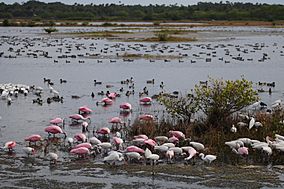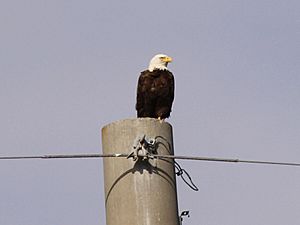Merritt Island National Wildlife Refuge facts for kids
Quick facts for kids Merritt Island National Wildlife Refuge |
|
|---|---|
|
IUCN Category IV (Habitat/Species Management Area)
|
|

Ibises, roseate spoonbills and egrets at Merritt Island National Wildlife Reserve, Florida United States.
|
|
| Location | Merritt Island, Brevard County, Florida, United States |
| Nearest city | Titusville, Florida |
| Area | 140,000 acres (570 km2) |
| Established | 1963 |
| Governing body | U.S. Fish and Wildlife Service |
| Website | Merritt Island National Wildlife Refuge |
The Merritt Island National Wildlife Refuge is a huge natural area in Florida, USA. It covers about 140,000 acres (that's like 100,000 football fields!). This special place is on Florida's biggest barrier island, right next to the Atlantic Ocean.
It's unique because it shares space with NASA's Kennedy Space Center. Sometimes, NASA needs to close parts of the refuge for its rocket launches or other activities. This refuge is home to over 1,000 types of plants and many different animals. You can find 117 kinds of fish, 68 types of amphibians and reptiles, 330 kinds of birds, and 31 types of mammals here. It's a very important spot for wildlife!
Contents
Where is the Refuge?
The Merritt Island National Wildlife Refuge is located on Merritt Island, just east of Titusville. It's in Brevard County, Florida. The refuge covers a large area, about 140,000 acres, and it's mixed in with the Kennedy Space Center.
To the north, it touches the Canaveral National Seashore. To the south, it includes parts of the Kennedy Space Center that aren't open to the public. The Mosquito Lagoon and the Indian River also flow through the refuge. Because access to these areas is controlled, it means a huge part of this land is kept safe for wildlife.
A Bit of History
NASA bought the land for the refuge in the early 1960s. They needed the space to build the Kennedy Space Center. Before NASA bought the land, not many people lived or built things there. This was mainly because of the large number of salt marsh mosquitoes!
Even though NASA owns the land, the public can usually visit the refuge. Some roads even cross through it. However, NASA can close the refuge to visitors when they need to, especially a few days before a rocket launch. This helps keep everyone safe.
Amazing Animals and Habitats
The refuge has many different types of natural areas, called habitats. You can find saltwater estuaries (where fresh and salt water mix), freshwater marshes, sand dunes, hardwood forests (called hammocks), and dry scrub areas. This variety of habitats is why so many different animals can live here.
As mentioned, over 1,000 types of plants grow here. There are also 117 kinds of fish, 68 types of amphibians and reptiles, 330 kinds of birds, and 31 kinds of mammals. It's a very important place for many animals.
Some of the animals that live or visit the refuge are:
- Sea turtles, including:
- American alligator
- Osprey (a type of fish-eating bird)
- Bald eagle (the national bird of the U.S.)
- Many kinds of waterfowl (ducks, geese) that spend the winter here.
- Lots of shorebirds, some live here all the time, and others stop during their migration journeys.
- Several types of rails (marsh birds).
- Anhinga (a diving bird).
- Many kinds of herons and egrets.
- Glossy and white ibis (birds with long, curved beaks).
- Roseate spoonbill (a beautiful pink bird).
- Florida scrub jay (a special bird found only in Florida).
- West Indian manatee (a gentle sea mammal).
- Bobcat (a wild cat).
- Dwarf siren (a newly found type of salamander).
Things to Do at the Refuge
You can visit the refuge during the day, but camping is usually only for special youth groups.
The refuge has trails for hiking and driving. These trails let you see the wildlife without disturbing them. You can often spot many of the animals listed above! There's even a special observation deck near the drawbridge on State Road 3. This is a great spot to see manatees, as they often gather there.
You can also go boating in the waters around and within the refuge. This is another way to see the animals. There are places to launch your boat. The refuge also gives you access to Playalinda Beach, which is on the outer barrier island.
Fishing is generally allowed, and there's limited hunting for wildfowl. There is also a Visitor Center where you can learn more about the refuge.
How the Refuge is Managed
The U.S. Fish and Wildlife Service manages the Merritt Island National Wildlife Refuge. They work to protect the different habitats and the animals that live there. They also manage the St. Johns National Wildlife Refuge and Lake Woodruff National Wildlife Refuge.
One important way they protect the habitats is by controlling water levels in most parts of the refuge. They also use controlled fires regularly. These fires help keep the land healthy and prevent bigger, uncontrolled fires.
Roads for Wildlife Viewing
The Black Point Wildlife Drive is a special one-way, seven-mile road. It's built on a dike and allows you to drive slowly and watch for wildlife. It's a great way to see many of the refuge's animals from your car.
Kennedy Parkway
The Kennedy Parkway goes through both the John F. Kennedy Space Center and the refuge. It's a long road, about 28 miles in total. Part of it is a divided highway. This road helps visitors get around and see different parts of this large area.
Images for kids






